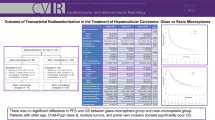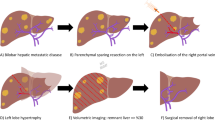Abstract
Objectives
In HCC, locoregional therapy (LRT) is performed as a bridging or downstaging treatment before curative surgery. The impact of the LI-RADS Treatment Response (LR-TR) algorithm on surgical outcomes remains unknown. We aimed to evaluate radiologic and clinical factors predicting recurrence-free survival (RFS) and overall survival (OS) after curative surgery for LRT-treated HCC.
Materials and methods
Consecutive HCC patients who underwent liver transplantation or curative resection after LRT from 2010 to 2016 and had baseline and follow-up post-LRT CT/MRI up to the point of surgery were included. The LR-TR category at the time of surgery and other features were assessed using Cox proportional hazard models. RFS was estimated and compared using the Kaplan-Meier method with log-rank tests.
Results
We evaluated 73 patients with 115 lesions. The LR-TR viable category at the time of surgery (hazard ratio [HR], 3.84; 95% confidence interval [CI]: 1.04, 14.16), preoperative AFP > 200 ng/mL (HR, 3.63; 95% CI: 1.63, 8.10), LRT sessions > 3 (HR, 4.99; 95% CI: 1.73, 14.38), and resection (HR, 3.35; 95% CI: 1.39, 8.09) independently predicted recurrence. The risk score categorized the patients into poor, intermediate, and favorable-risk groups with 1-year RFS rates of 35.0%, 78.3%, and 97.0%, respectively (p < 0.001). Outside Milan at the time of surgery (HR, 5.79; 95% CI: 1.94, 17.07) and recurrence within the first postoperative year (HR, 17.66; 95% CI: 6.42, 48.56) predicted death.
Conclusion
In LRT-treated HCC, non-LR-TR viable disease achieved within fewer LRT sessions and removed by liver transplantation recurred less.
Key Points
• The Liver Imaging Reporting and Data System treatment response (LR-TR) viable disease (hazard ratio [HR], 3.84; p = 0.043), preoperative serum AFP level > 200 ng/mL (HR, 3.63; p = 0.002), more than three locoregional treatment (LRT) sessions (HR, 4.99; p = 0.003), and resection compared to liver transplantation (HR, 3.35; p = 0.001) were the independent predictors for postsurgical recurrence in LRT-treated HCCs.
• A scoring system combining LR-TR categories and key clinical factors stratifies the patients into poor, intermediate, and favorable recurrence risk groups, with 1-year RFS rates of 35.0%, 78.3%, and 97.0%, respectively (p < 0.001).
• Outside Milan at the time of surgery (HR, 5.79; p = 0.001) and recurrence within the first postoperative year (HR, 17.66; p < 0.001) were associated with poor overall survival.






Similar content being viewed by others
Abbreviations
- AFP:
-
Alpha-fetoprotein
- CI:
-
Confidence interval
- CR:
-
Complete response
- HCC:
-
Hepatocellular carcinoma
- LI-RADS:
-
Liver Imaging Reporting and Data System
- LRT:
-
Locoregional therapy
- LR-TR:
-
Liver Imaging Reporting and Data System treatment response
- LT:
-
Liver transplantation
- OS:
-
Overall survival
- RFS:
-
Recurrence-free survival
- TACE:
-
Transarterial chemoembolization
- β :
-
Regression coefficient
References
European Association for the Study of the Liver (2018) EASL clinical practice guidelines: management of hepatocellular carcinoma. J Hepatol 69:182–236
Heimbach JK, Kulik LM, Finn RS et al (2018) AASLD guidelines for the treatment of hepatocellular carcinoma. Hepatology 67:358–380
Akateh C, Black SM, Conteh L et al (2019) Neoadjuvant and adjuvant treatment strategies for hepatocellular carcinoma. World J Gastroenterol 25:3704–3721
Toso C, Mentha G, Kneteman NM, Majno P (2010) The place of downstaging for hepatocellular carcinoma. J Hepatol 52:930–936
Yamashita S, Aoki T, Inoue Y et al (2015) Outcome of salvage hepatic resection for recurrent hepatocellular carcinoma after radiofrequency ablation therapy. Surgery 157:463–472
Imai K, Beppu T, Chikamoto A et al (2014) Salvage treatment for local recurrence of hepatocellular carcinoma after local ablation therapy. Hepatol Res 44:E335–E345
Huang J, Huang W, Guo Y et al (2021) Risk factors, patterns, and long-term survival of recurrence after radiofrequency ablation with or without transarterial chemoembolization for hepatocellular carcinoma. Front Oncol 11:638428
Otto G, Schuchmann M, Hoppe-Lotichius M et al (2013) How to decide about liver transplantation in patients with hepatocellular carcinoma: size and number of lesions or response to TACE? J Hepatol 59:279–284
Morris PD, Laurence JM, Yeo D et al (2017) Can response to locoregional therapy help predict longterm survival after liver transplantation for hepatocellular carcinoma? A systematic review. Liver Transplantation 23:375–385
Lencioni R, Llovet JM (2010) Modified RECIST (mRECIST) assessment for hepatocellular carcinoma. Semin Liver Dis 30:52–60
Vincenzi B, Di Maio M, Silletta M et al (2015) Prognostic relevance of objective response according to EASL Criteria and mRECIST criteria in hepatocellular carcinoma patients treated with loco-regional therapies: a literature-based meta-analysis. PLoS One:10
Kim BK, Kim SU, Kim KA et al (2015) Complete response at first chemoembolization is still the most robust predictor for favorable outcome in hepatocellular carcinoma. J Hepatol 62:1304–1310
Edeline J, Boucher E, Rolland Y et al (2012) Comparison of tumor response by Response Evaluation Criteria in Solid Tumors (RECIST) and modified RECIST in patients treated with sorafenib for hepatocellular carcinoma. Cancer 118:147–156
CT/MRI Liver Imaging-Reporting and Data System (LI-RADS®) v2018 CORE – American College of Radiology [cited 2021 Nov 15]. Web site. https://www.acr.org/Clinical-Resources/Reporting-and-Data-Systems/LI-RADS/CT-MRI-LI-RADS-v2018
Youn SY, Kim DH, Choi SH et al (2021) Diagnostic performance of Liver Imaging Reporting and Data System treatment response algorithm: a systematic review and meta-analysis. Eur Radiol 31:4785–4793
Seo N, Kim MS, Park M-S et al (2020) Evaluation of treatment response in hepatocellular carcinoma in the explanted liver with Liver Imaging Reporting and Data System version 2017. Eur Radiol 30:261–271
Chaudhry M, McGinty KA, Mervak B et al (2019) The LI-RADS version 2018 MRI treatment response algorithm: evaluation of ablated hepatocellular carcinoma. Radiology 294:320–326
Kim SW, Joo I, Kim HC et al (2020) LI-RADS treatment response categorization on gadoxetic acid-enhanced MRI: diagnostic performance compared to mRECIST and added value of ancillary features. Eur Radiol 30:2861–2870
Gupta P, Bansal A, Das GC et al (2021) Diagnostic accuracy of Liver Imaging Reporting and Data System locoregional treatment response criteria: a systematic review and meta-analysis. Eur Radiol 31:7725–7733
Pirasteh A, Sorra EA, Marquez H et al (2021) LI-RADS treatment response algorithm after first-line DEB-TACE: reproducibility and prognostic value at initial post-treatment CT/MRI. Abdom Radiol (NY) 46:3708–3716
Ormiston WEL, Yarmohammadi H, Lobaugh S et al (2021) Post-treatment CT LI-RADS categories: predictors of overall survival in hepatocellular carcinoma post bland transarterial embolization. Abdom Radiol (NY) 46:3738–3747
Vatcheva KP, Lee M, McCormick JB, Rahbar MH (2016) Multicollinearity in regression analyses conducted in epidemiologic studies. Epidemiology (Sunnyvale) 6:227
Rhu J, Kim JM, Choi GS, Kwon CHD, Joh JW (2018) Continuing five or more locoregional therapies before living donor salvage liver transplantation for hepatocellular carcinoma is related to poor recurrence-free survival. Ann Surg Treat Res 95:152–160
DiNorcia J, Florman SS, Haydel B et al (2020) Pathologic response to pretransplant locoregional therapy is predictive of patient outcome after liver transplantation for hepatocellular carcinoma: analysis from the US Multicenter HCC Transplant Consortium. Ann Surg 271:616–624
Bae JS, Lee JM, Yoon JH et al (2021) Evaluation of LI-RADS version 2018 treatment response algorithm for hepatocellular carcinoma in liver transplant candidates: intraindividual comparison between CT and hepatobiliary agent–enhanced MRI. Radiology 299:336–345
Shropshire EL, Chaudhry M, Miller CM et al (2019) LI-RADS treatment response algorithm: performance and diagnostic accuracy. Radiology 292:226–234
Funding
The authors state that this work has not received any funding.
Author information
Authors and Affiliations
Corresponding author
Ethics declarations
Guarantor
The scientific guarantor of this publication is Bohyun Kim.
Conflict of interest
The authors declare no competing interests.
Statistics and biometry
One of the authors has significant statistical expertise.
Informed consent
Written informed consent was waived by the Institutional Review Board.
Ethics approval
Institutional Review Board approval was obtained.
Methodology
• Retrospective
• Diagnostic or prognostic study
• Performed at one institution
Additional information
Publisher’s note
Springer Nature remains neutral with regard to jurisdictional claims in published maps and institutional affiliations.
Supplementary information
ESM 1
(DOCX 235 kb)
Rights and permissions
About this article
Cite this article
Youn, S.Y., Kim, B., Kim, D.H. et al. Liver Imaging-Reporting and Data System treatment response algorithm predicts postsurgical recurrence in locoregional therapy–treated hepatocellular carcinoma. Eur Radiol 32, 6270–6280 (2022). https://doi.org/10.1007/s00330-022-08720-8
Received:
Revised:
Accepted:
Published:
Issue Date:
DOI: https://doi.org/10.1007/s00330-022-08720-8




